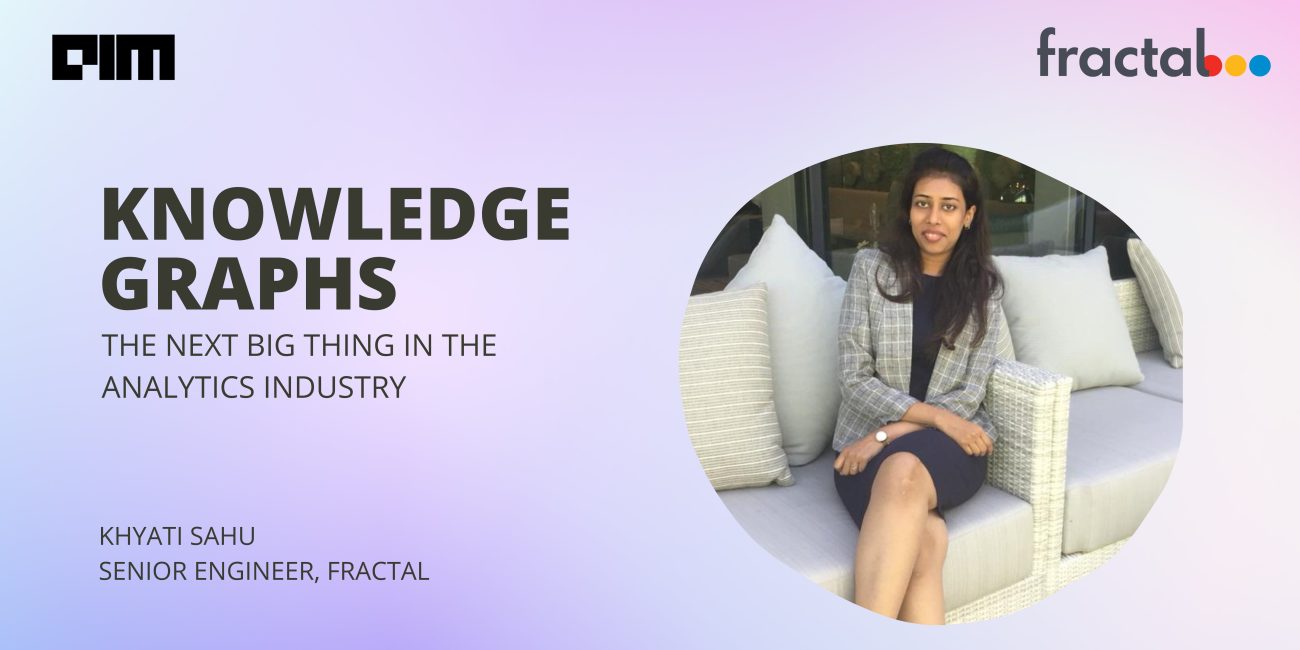|
Listen to this story
|
One of the earliest references to knowledge graphs can be traced back to the 1980s when the Universities of Groningen and Twente began a project of that name. The project focused on semantic networks with edges to facilitate algebras on the graph. Today, a knowledge graph is a model that uses a graph-structured data model to integrate data.
To know more, AIM interviewed Khyati Sahu, a senior engineer at Fractal. Working as a data architect, Sahu describes her role to be techno-functional in nature. She handles a team of engineers and manages projects from a technical point of view. “My responsibilities include gathering requirements and interacting with the customers to understand their needs,” Sahu told AIM.
After her postgraduate studies at IIT Roorkee, Sahu has been working in the field for over eight years now, two of which have been at Fractal. A big part of her work involves employing knowledge graphs.
AIM: What are knowledge graphs
Khyati Sahu: Knowledge graphs comprise entities that can form a node, and the relationship between them is traced. Their goal is to provide meaning to the data and remove any semantic ambiguity and help in moving toward data analytics and intelligence. The primary use of knowledge graphs is found in search and recommendation systems.
For instance, when you search for a person on Google, you will get a summary panel – containing information about their birth date, height, weight, and family members, among others. All this information is being fetched internally from knowledge graphs. At Fractal, I am working for a client who is a Fortune 500 client in the CPG domain. We have been building a recommender system for them. For example, we use a knowledge graph-based system to recommend a store for certain products based on its geographical location. And depending on whether there is a school or a hospital nearby, the sales and revenue of the store will increase.
AIM: Are knowledge graphs restricted to academia?
Khyati Sahu: No, in fact, knowledge graphs are being used for a wide range of applications like space, journalism, biomedicine, entertainment, network security, and pharmaceuticals. In the financial industry vertical, knowledge graphs are used for analytics, tax calculations, and financial reporting. Machine learning algorithms have already helped financial institutions monitor fraud and the risk behind it more automatedly. Knowledge graphs allow the graphical representation of fraud scenarios and help in better decision-making. Of course, there are limitations, like maintaining them, which may prompt people to look for alternatives. However, there has been constant innovation to overcome these challenges. Knowledge graphs will likely be the next big thing in the AI and analytics industry, and more people will adopt them.
AIM: How to construct a knowledge graph?
Khyati Sahu: In order to construct a knowledge graph, we combine both structured and unstructured data and extract the entities and relationships between them right. These form the schema of the model.
First, you need to determine the use cases for your knowledge graph. Once you’ve decided that, there are a few things to keep in mind throughout the build:
1) All knowledge graphs start with data
2) Building them will be iterative
3) Always build it through the lens of your use case
Next, take a closer look at all the information available from a field of knowledge. Identify all the categories, types, things, and objects important to the field, and outline the necessary data needed. Once you have identified your data, you need to organise it and map relationships with ontologies. The “graph” in the knowledge graph refers to organising data and highlighting relationships between data points.
These relationships are key to keeping knowledge graphs nimble. Once you’ve identified and organised your data in the context of your original use case and business questions, it’s time to focus on the relationships between all this data. Ontology management and knowledge graph development are iterative processes and will evolve with time.
However, as I mentioned before, maintaining them is a problem area. In addition, when the graph grows and new data is added, integration and maintaining correctness across the knowledge graph becomes a concern.
AIM: Are knowledge graphs the next big thing in AI?
Khyati Sahu: Yes, absolutely. Knowledge graph allows AI systems to deal with complex, interrelated data. It stores information as a network of data points connected by different types of relations. Knowledge graphs power internet search, recommender systems, and chatbots. Artificial intelligence has become invaluable in storing and organising large amounts of data using knowledge graphs. Including knowledge, graphs can improve the accuracy of the outcomes and augment the potential of machine-learning approaches.


























